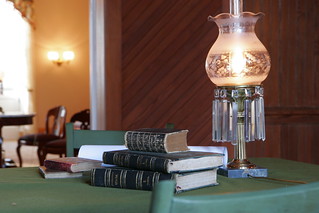 |
| The Library and its books / NTHP Photo |
The fact is that I wasn't the most beloved tour guide during my time in the Cottage, chiefly because I consistently stepped outside of the relatively tightly-defined box of the tour outline. Fellow Cottage alum Allison Hermann (cum Jordan) can attest to that. I broke nearly every rule of visitor experience that was strenuously laid out by management in those first tenuous months of the Cottage being open. I was breaking the rules chiefly for visitor understanding, appreciation and enjoyment, but I was still stepping outside of the box left and right. My free-form interpretive philosophy didn't really jibe with the NTHP's very strictly controlled and scripted philosophy.
That's not to say I didn't get things out of my time there. There are chunks of my interpretive philosophy which spring nearly full-formed from both the great and shabby things I saw at the Cottage. There are ideas which started rattling around in my head five years ago and which are still falling out of my mouth, often unbidden.
One of the most interesting concepts the Cottage employed (they may still employ it, it's been five years since I've visited) was in the library. On the table sat original, mid-1850s editions of some of Lincoln's favorite books. Part of the explanation given to staff as to why these were real, original editions of Lincoln's favorite books was the simple fact that finding originals in used book stores was far less expensive than having custom reproductions handmade.
Regardless of why these books were there to be touched, the fact is they were there to be touched. They were classified as consumptive use. They would eventually wear out and then-curator Erin Carlson Mast would need to find new ones. The books were intended to be used, touched, handled and eventually destroyed for the sake of the story.
 |
| My collection of books which will eventually be destroyed. |
But these books were there in service of making real, visceral connections to the past. They would be touched. There was no glass. They would be abused. There was no barrier. They would ultimately be destroyed.
But that destruction would not be a loss. It would be a gain for the thousands of fingers that touched the pages, felt the leather, rubbed the cloth and weighed history in their hands. They would feel Lincoln by feeling his favorite books in their own hands.
So I've begun to amass my own collection of consumptive use books. They're intended to help tell the story. They're books that soldiers borrowed from professors to wile away the hours of boredom. They're books that professors obsessively crafted in the months after the battle then obsessively sold to a slavering American public. They're books in which bored Confederates inscribed their names, forever to be graphite prisoners in a Yankee library. I'll carry them around, walk to the places around the Pennsylvania College campus where their cousins, books that looked and smelled and felt just like these, met with the people of the past. I'll tell their tales again. I'll hoist them in front of eager eyes. I'll pass them around through sweaty, dirty hands of the people who can feel the past through their pages. And someday, they'll fall to pieces.
And I'll head over to Abebooks.com and replace them. And then replace them again. And again.
You see, this destruction is all about meaning. Because if there's anything that the Lincoln Cottage taught me, it's that sometimes the best way to preserve the past is to destroy it in slow increments.
 |
| That's me, leading Gettysburg Semester students around the Cottage. / NTHP Photo |
No comments:
Post a Comment